Balbharti Maharashtra State Board Class 10 Maths Solutions covers the Practice Set 4.1 Geometry 10th Class Maths Part 2 Answers Solutions Chapter 4 Geometric Constructions.
10th Standard Maths 2 Practice Set 4.1 Chapter 4 Geometric Constructions Textbook Answers Maharashtra Board
Class 10 Maths Part 2 Practice Set 4.1 Chapter 1 Geometric Constructions Questions With Answers Maharashtra Board
Question 1.
∆ABC ~ ∆LMN. In ∆ABC, AB = 5.5 cm, BC = 6 cm, CA = 4.5 cm. Construct ∆ABC and ∆LMN such that \(\frac { BC }{ MN } \) = \(\frac { 5 }{ 4 } \)
Solution:
Analysis:
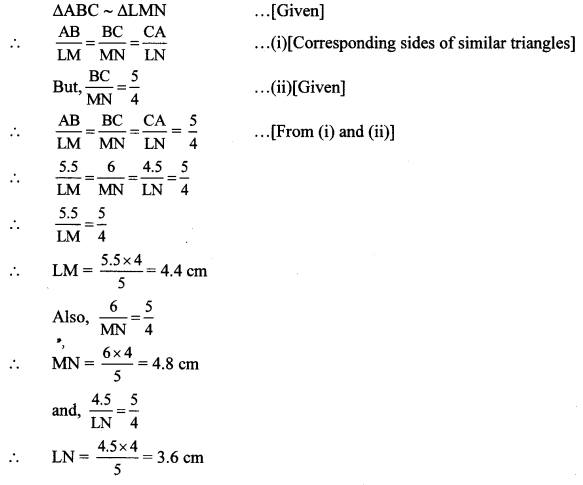
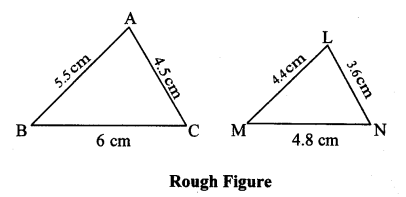
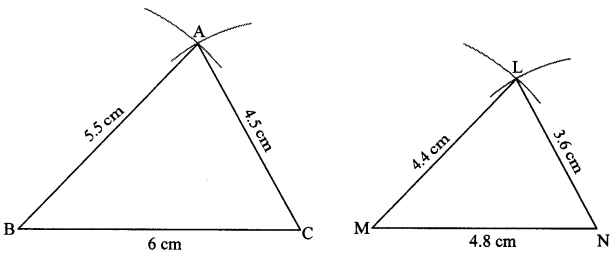
Question 2.
∆PQR ~ ∆LTR. In ∆PQR, PQ = 4.2 cm, QR = 5.4 cm, PR = 4.8 cm. Construct ∆PQR and ∆LTR, such that \(\frac { PQ }{ LT } \) = \(\frac { 3 }{ 4 } \)
Solution:
Analysis:
As shown in the figure, Let R – P – L and R – Q – T.
∆PQR ~ ∆LTR … [Given]
∴ ∠PRQ ≅ ∠LRT … [Corresponding angles of similar triangles]
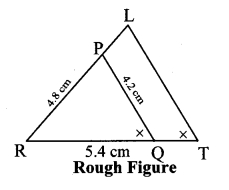
\(\frac { PQ }{ LT } \) = \(\frac { QR }{ TR } \) = \(\frac { PR }{ LR } \) …(i)[Corresponding sides of similar triangles]
But, \(\frac { PQ }{ LT } \) = \(\frac { 3 }{ 4 } \) ….(ii) [Given]
∴ \(\frac { PQ }{ LT } \) = \(\frac { QR }{ TR } \) = \(\frac { PR }{ LR } \) = \(\frac { 3 }{ 4 } \) …[From (i) and (ii)]
∴ sides of LTR are longer than corresponding sides of ∆PQR.
If seg QR is divided into 3 equal parts, then seg TR will be 4 times each part of seg QR.
So, if we construct ∆PQR, point T will be on side RQ, at a distance equal to 4 parts from R.
Now, point L is the point of intersection of ray RP and a line through T, parallel to PQ.
∆LTR is the required triangle similar to ∆PQR.
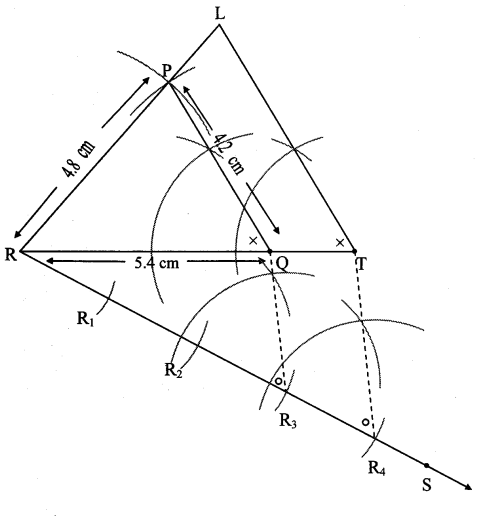
Steps of construction:
i. Draw ∆PQR of given measure. Draw ray RS making an acute angle with side RQ.
ii. Taking convenient distance on the compass, mark 4 points R
1
, R
2
, R
3
, and R
4
, such that RR
1
= R
1
R
2
= R
2
R
3
= R
3
R
4
.
iii. Join R
3
Q. Draw line parallel to R
3
Q through R
4
to intersects ray RQ at T.
iv. Draw a line parallel to side PQ through T. Name the point of intersection of this line and ray RP as L.
∆LTR is the required triangle similar to ∆PQR.
Question 3.
∆RST ~ ∆XYZ. In ∆RST, RS = 4.5 cm, ∠RST = 40°, ST = 5.7 cm. Construct ∆RST and ∆XYZ, such that \(\frac { RS }{ XY } \) = \(\frac { 3 }{ 5 } \).
Solution:
Analysis:
∆RST ~ ∆XYZ … [Given]
∴ ∠RST ≅ ∠XYZ = 40° … [Corresponding angles of similar triangles]
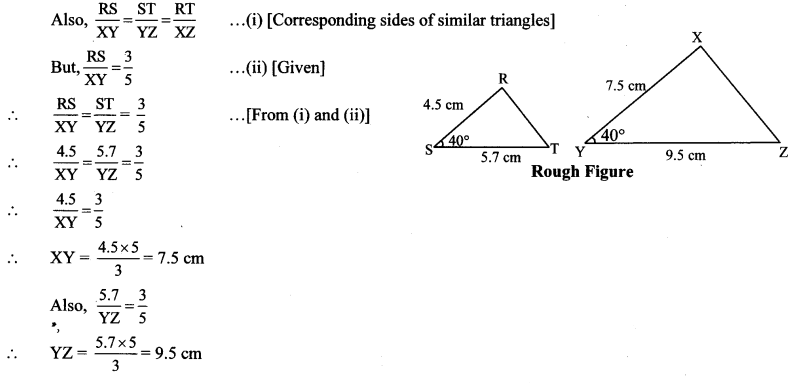
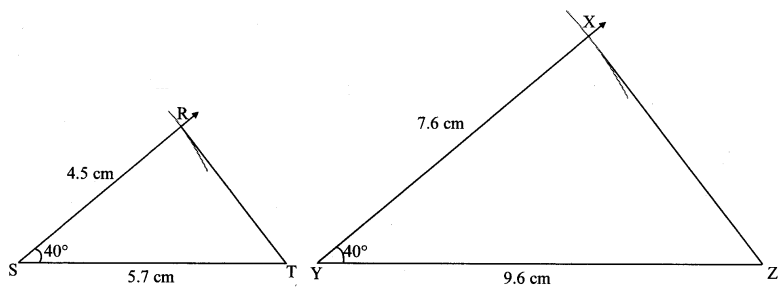
Question 4.
∆AMT ~ ∆ANE. In ∆AMT, AM = 6.3 cm, ∠TAM = 500, AT = 5.6 cm. \(\frac { AM }{ AH } \) = \(\frac { 7 }{ 5 } \) Construct ∆AHE.
Solution:
Analysis:
As shown in the figure,
Let A – H – M and A – E – T.
∆AMT ~ ∆AHE … [Given]
∴ ∠TAM ≅ ∠EAH … [Corresponding angles of similar triangles]
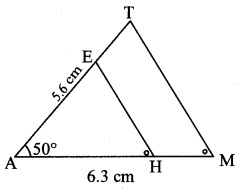
\(\frac { AM }{ AH } \) = \(\frac { MT }{ HE } \) = \(\frac { AT }{ AE } \) ….. (i)[Corresponding sides of similar triangles]
But, \(\frac { AM }{ AH } \) = \(\frac { 7 }{ 5 } \) …(ii)[Given]
∴ \(\frac { AM }{ AH } \) = \(\frac { MT }{ HE } \) = \(\frac { AT }{ AH } \) = \(\frac { 7 }{ 5 } \) …[From (i) and (ii)]
∴ Sides of AAMT are longer than corresponding sides of ∆AHE.
∴ The length of side AH will be equal to 5 parts out of 7 equal parts of side AM.
So, if we construct AAMT, point H will be on side AM, at a distance equal to 5 parts from A.
Now, point E is the point of intersection of ray AT and a line through H, parallel to MT.
∆AHE is the required triangle similar to ∆AMT.
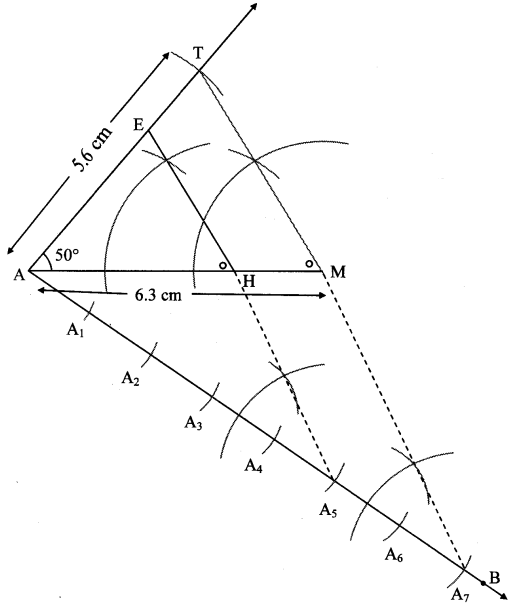
Steps of construction:
i. Draw ∆AMT of given measure. Draw ray AB making an acute angle with side AM.
ii. Taking convenient distance on the compass, mark 7 points A1, A2, A3, A4, A5, Ag and A7, such that
AA
1
= A
1
A
2
= A
2
A
3
= A
3
A
4
= A
4
A
5
= A
5
A
6
= A
6
A
7
.
iii. Join A
7
M. Draw line parallel to A
7
M through A
5
to intersects seg AM at H.
iv. Draw a line parallel to side TM through H. Name the point of intersection of this line and seg AT as E.
∆AHE is the required triangle similar to ∆AMT.
Maharashtra Board Class 10 Maths Chapter 4 Geometric Constructions Intext Questions and Activities
Question 1.
If length of side AB is \(\frac { 11.6 }{ 2 } \) cm, then by dividing the line segment of length 11.6 cm in three equal parts, draw segment AB. (Textbook pg. no. 93)
Solution:
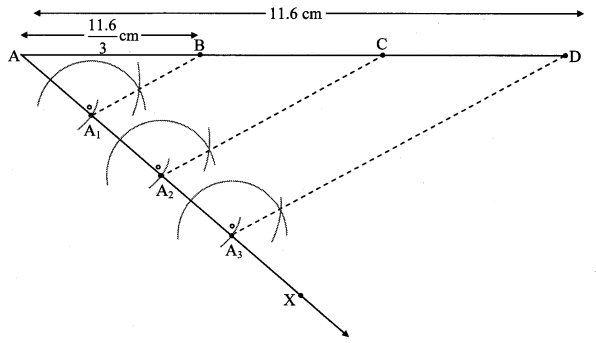
Steps of construction:
i. Draw seg AD of 11.6 cm.
ii. Draw ray AX such that ∠DAX is an acute angle.
iii. Locate points A
1
, A
2
and A
3
on ray AX such that AA
1
= A
1
A
2
= A
2
A
3
iv. Join A
3
D.
v. Through A
1
, A
2
draw lines parallel to A
3
D intersecting AD at B and C, wherein
AB = \(\frac { 11.6 }{ 3 } \) cm
Question 2.
Construct any ∆ABC. Construct ∆ A’BC’ such that AB : A’B = 5:3 and ∆ ABC ~ ∆ A’BC’. (Textbook pg. no. 93)
Analysis:
As shown in the figure,
Let B – A’ – A and B – C’ -C
∆ ABC – A’BC’ … [Given]
∴ ∠ABC ≅ ∠A’BC’ …[Corresponding angles of similar trianglesi

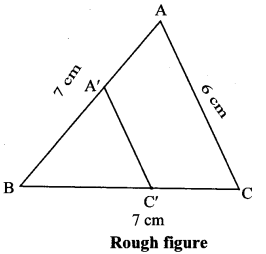
∴ Sides of ∆ABC are longer than corresponding sides of ∆A’BC’. Rough figure
∴ the length of side BC’ will be equal to 3 parts out of 5 equal parts of side BC.
So if we construct ∆ABC, point C’ will be on side BC, at a distance equal to 3 parts from B.
Now A’ is the point of intersection of AB and a line through C’, parallel to CA.
Solution:
Let ∆ABC be any triangle constructed such that AB = 7 cm, BC = 7 cm and AC = 6 cm.
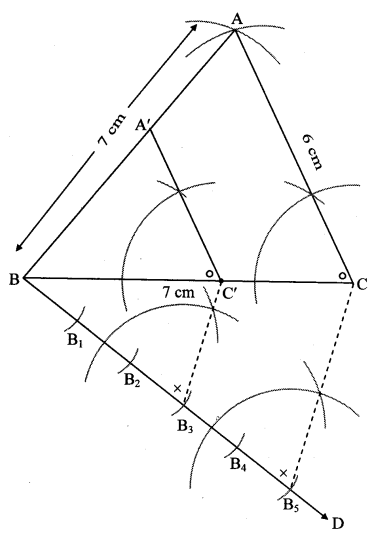
Question 3.
Construct any ∆ABC. Construct ∆A’BC’ such that AB: A’B = 5:3 and ∆ABC ~ ∆A’BC’.
∆A’BC’ can also be constructed as shown in the adjoining figure. What changes do we have to make in steps of construction in that case? (Textbook pg. no. 94)
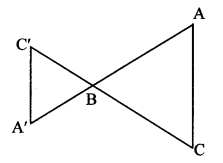
Solution:
Let ∆ABC be any triangle constructed such that AB = 5cm,
BC = 5.5 cm and AC = 6 cm.
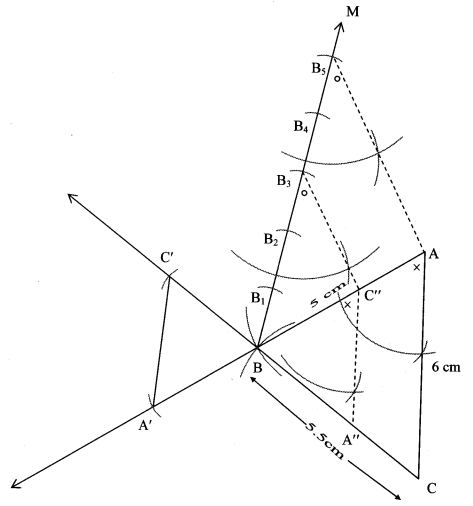
i. Steps of construction:
Construct ∆ABC, extend rays AB and CB.
Draw line BM making an acute angle with side AB.
Mark 5 points B
1
, B
2
, B
3
, B
4
, B
5
starting from B at equal distance.
Join B
3
C” (ie 3rd part)
Draw a line parallel to AB
5
through B
3
to intersect line AB at C”
Draw a line parallel to AC through C” to intersect line BC at A”
ii. Extra construction:
With radius BC” cut an arc on extended ray CB at C’ [C’ – B – C]
With radius BA” cut an arc on extended ray AB at A’ [A’ – B – A]
∆A’BC’ is the required triangle.